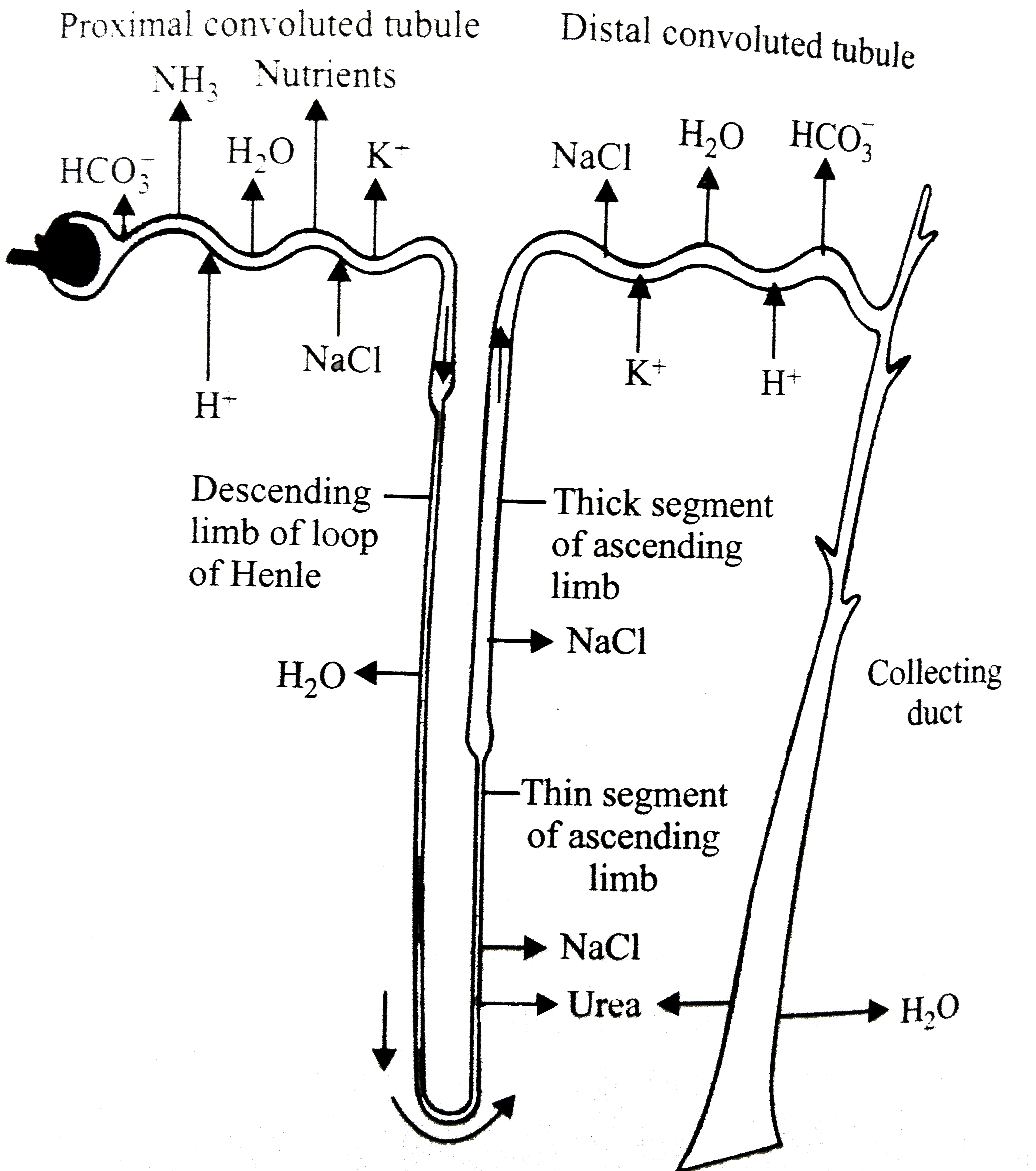Draw a labelled diagram showing reabsorption and secretion of major substances at different parts of the nephron.
Step-by-Step Solution:
1. Understanding the Nephron Structure:
- The nephron is the functional unit of the kidney, consisting of several parts: Bowman's capsule, proximal convoluted tubule (PCT), loop of Henle, distal convoluted tubule (DCT), and collecting duct.
2. Drawing the Diagram:
- Start by sketching the kidney shape, indicating the cortex (outer region) and medulla (inner region).
- Inside the kidney, draw a nephron with the following parts:
- Bowman's Capsule: A bulb-like structure at the beginning of the nephron.
- Proximal Convoluted Tubule (PCT): A coiled tube following the Bowman's capsule.
- Loop of Henle: A U-shaped structure with descending and ascending limbs.
- Distal Convoluted Tubule (DCT): A coiled tube that follows the loop of Henle.
- Collecting Duct: The final part where urine collects before moving to the bladder.
3. Labeling the Diagram:
- Label each part of the nephron: Bowman's Capsule, PCT, Loop of Henle (with ascending and descending limbs), DCT, and Collecting Duct.
- Indicate the cortex and medulla regions of the kidney.
4. Indicating Reabsorption and Secretion:
- Bowman's Capsule: Indicate ultrafiltration of blood.
- Proximal Convoluted Tubule (PCT):
- Reabsorption: Water, NaCl, bicarbonate, nutrients, and potassium ions.
- Secretion: Ammonia and hydrogen ions.
- Loop of Henle:
- Reabsorption: Water (in descending limb), NaCl (in ascending limb).
- Distal Convoluted Tubule (DCT):
- Reabsorption: NaCl, water, and bicarbonate.
- Secretion: Hydrogen and potassium ions.
- Collecting Duct: Indicate the reabsorption of excess water and the final formation of urine.
5. Final Touches:
- Ensure all parts are clearly labeled and the processes of reabsorption and secretion are indicated with arrows or notes.
- The nephron is the functional unit of the kidney, consisting of several parts: Bowman's capsule, proximal convoluted tubule (PCT), loop of Henle, distal convoluted tubule (DCT), and collecting duct.
- Start by sketching the kidney shape, indicating the cortex (outer region) and medulla (inner region).
- Inside the kidney, draw a nephron with the following parts:
- Bowman's Capsule: A bulb-like structure at the beginning of the nephron.
- Proximal Convoluted Tubule (PCT): A coiled tube following the Bowman's capsule.
- Loop of Henle: A U-shaped structure with descending and ascending limbs.
- Distal Convoluted Tubule (DCT): A coiled tube that follows the loop of Henle.
- Collecting Duct: The final part where urine collects before moving to the bladder.
- Label each part of the nephron: Bowman's Capsule, PCT, Loop of Henle (with ascending and descending limbs), DCT, and Collecting Duct.
- Indicate the cortex and medulla regions of the kidney.
- Bowman's Capsule: Indicate ultrafiltration of blood.
- Proximal Convoluted Tubule (PCT):
- Reabsorption: Water, NaCl, bicarbonate, nutrients, and potassium ions.
- Secretion: Ammonia and hydrogen ions.
- Loop of Henle:
- Reabsorption: Water (in descending limb), NaCl (in ascending limb).
- Distal Convoluted Tubule (DCT):
- Reabsorption: NaCl, water, and bicarbonate.
- Secretion: Hydrogen and potassium ions.
- Collecting Duct: Indicate the reabsorption of excess water and the final formation of urine.
- Ensure all parts are clearly labeled and the processes of reabsorption and secretion are indicated with arrows or notes.
Topper's Solved these Questions
- EXCRETORY PRODUCTS AND THEIR ELIMINATION BOOK - NCERT EXEMPLAR ENGLISHCHAPTER - EXCRETORY PRODUCTS AND THEIR ELIMINATION EXERCISE - Short Answer Type Questions
9 Videos
- DIGESTION AND ABSORPTION BOOK - NCERT EXEMPLAR ENGLISHCHAPTER - DIGESTION AND ABSORPTION EXERCISE - Long Answer Type Questions
5 Videos
- LOCOMOTION AND MOVEMENTBOOK - NCERT EXEMPLAR ENGLISHCHAPTER - LOCOMOTION AND MOVEMENTEXERCISE - Long Answer Type Questions
6 Videos
Similar Questions
Knowledge Check

The given figure shows reabsorption and secretion of major substances at different parts of the nephron. The movelment of which of the following substances is wrongly depicted?ANaCl and K+ at DCTBNaCl and NH3 at PCTCNaCl at ascending limb of loop of HenleDH2O at descending limb of loop of Henle
Draw a labeled diagram of sperm.
View SolutionDraw a labelled diagram of synapse.
View SolutionDraw a labelled diagram of a neuron
View SolutionDraw a labelled diagram of human heart.
View SolutionDraw a labelled diagram of a neuron.
View SolutionDraw a labelled diagram of human ovum.
View SolutionDraw a labelled diagram of renal corpuscle.
View Solution
